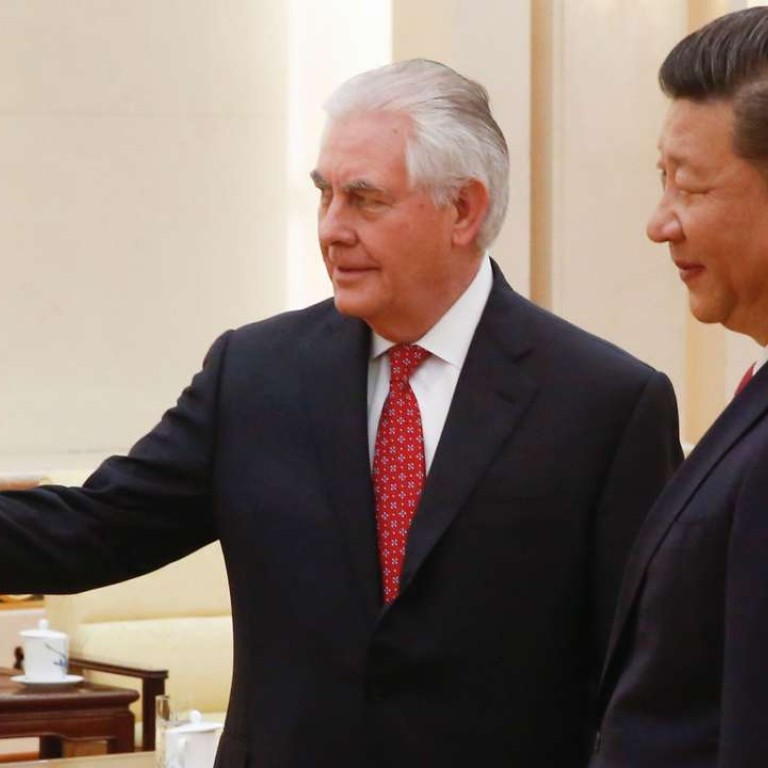
Will Xi and Trump find a meeting of minds over North Korea?
Andrew Hammond says despite bristly US-China exchanges over Pyongyang’s nuclear threat and the South’s hosting of THAAD, hopes of ‘cool-headedness’ prevail, especially with the usually hawkish Rex Tillerson’s visit underlining that Washington is seeking a new approach
Rex Tillerson on Sunday concluded his first trip to the Asia-Pacific region as US secretary of state, after stop-offs in Japan, South Korea and China.
Before Tillerson’s visit, Foreign Minister Wang Yi (王毅) asserted, in unusually blunt language, that Washington and Pyongyang were on a “head-on collision” course, and warned Tillerson on Saturday that “cool-headedness” was needed.
How Kim Jong-un put the US on a collision course with China
Successive US administrations have discovered that security tensions on the Korean peninsula have no easy resolution

US threat to strike North Korea is ‘aimed at Beijing’s ears’
The reason why China and the US differed last year over the scope and severity of international sanctions is that, concerned as Beijing is about Pyongyang’s behaviour, it does not want to push the regime so hard that it becomes significantly destabilised.
The real reason China won’t exert economic pressure on North Korea
From the vantage point of Chinese officials, this could result in even more unpredictable behaviour from North Korea, and/or the outside possibility of regime collapse, which would not be in Beijing’s interests: not least as it could lead to instability on the North Korea-China border and, ultimately, the potential emergence of a pro-US successor nation.
Beijing is also concerned that Washington might even be thinking, seriously, about a pre-emptive strike on North Korea’s nuclear capabilities. The risks of this are great, and this is one reason why Wang asserted earlier this month that “China’s priority now is to flash the red light and apply the brakes on both [the US and North Korean] trains” to avoid a collision.
North Korean nuclear threat at danger level, Tillerson tells Chinese hosts
In China, a second key element of Tillerson’s trip was focused on trying to put bilateral relations on a more even keel after the early disruptions of the Trump presidency. He also sought to finalise the agenda with his Chinese hosts for a landmark meeting between presidents Xi Jinping (習近平)and Donald Trump that is tentatively scheduled for next month.
Watch: Rex Tillerson at confirmation hearings compares China to Russia in Crimea
Underlying Trump’s own hawkish sentiment appears to be a conviction that China represents the primary threat to US interests globally. Yet, he has also acknowledged that Beijing can play a potentially constructive role in key policy areas, including North Korea.
While this US rhetoric indicates tensions could rise further between Beijing and Washington in the coming months, it should be remembered that the Obama administration left bilateral ties in relatively positive shape, despite a shaky start after Xi took office.
Then, Beijing’s foreign and military positions, and rhetoric, became significantly more pugnacious, but despite this – and numerous irritants that continue to this day, including alleged cyber attacks on US interests by Beijing – ties became generally cordial.

This reflected, in part, the personal commitment of Obama and Xi. Both men recognised the priority of bilateral ties and, under Obama, Washington pursued a strategy with Beijing that promoted cooperation on softer issues like energy and climate change, while seeking constructive engagement on vexed harder issues like the South China Sea tensions.
Meanwhile, Xi outlined, rhetorically at least, his desire to fundamentally redevelop a new type of great power relationship with the US to avoid the conflictual great power patterns of the past.
This is an audacious goal, which still lacks any obvious definition, and it is not certain if the pledge remains in place, given the rhetorical bellicosity of Trump to China.
Tillerson meets Xi Jinping, says Trump looking forward ‘to enhancing understanding’
Andrew Hammond is an associate at LSE IDEAS at the London School of Economics

